14 ways Buzzfeed found its Australian voice
Buzzfeed Australia has made a number of headlines of its own since launching last year. Nic Christensen sat down with some of its local team to talk about its model, what they’ve learned, and whether it has found its voice.
If you were to make a listicle of things Buzzfeed Australia has learnt in the last 18 months one of them might be this: avoid cute things.
“Australians really don’t like to share koalas and kangaroos,” says Simon Crerar Buzzfeed Australia editor, with a strong hint of bemusement.
“Our US bosses were very keen to find out which is more popular but the reality is Aussies don’t mind one kangaroo beating up another kangaroo, however they don’t like things that are cute.”
An Aussie aversion to cute koalas is just one of the challenges the now 27-strong Australian team has learnt about and adjusted to as Buzzfeed – a publisher most famous for love of cat videos and all things viral – joined the likes of the global giants The Guardian, Daily Mail and most recently Huffington Post in shaking up the local media scene.
Inside Buzzfeed Australia HQ
As I sit down with Crerar and some his team it’s their first day in a new larger office, that’s been upgraded to fit a growing operation.
Located in an incubator centre for startups in the heart of Sydney’s CBD, Buzzfeed’s Australia HQ looks very much like you’d expect: it’s modern, slightly cool, with its requisite ping pong table and office bar in the foyer.
There’s also something that strikes you as you walk into the newsroom, there’s no one working here over the age of 30 – except for Crerar.
“I am certainly the oldest person in the room,” concedes Crerar, who was visual story editor at News Corp’s national news desk before taking the Buzzfeed role.
“Most of the people who work for us are in their 20s but that’s because most of our audience is in their teens or 20 somethings.”
Crerar explains further why the Gen Y workforce is important: “The emergence of sites like ours, like Vice, show that people – young people in particular – are intensely curious about the world.
“They read news but they just aren’t doing that by picking up a newspaper in the morning and these guys get that – they live on the internet.”
A focus on the power of social sharing
In an address to media buyers and advertisers at Youtube’s Brandcast event in New York this year Buzzfeed’s video boss Ze Frank told the room: “(social sharing) is what we’re obsessed with. We want to understand why does some stuff spreads better than others.”
He also broke down the motives behind social sharing into three distinct groups: identity sharing, emotional gift and social information.
“What is exciting is that we are a laboratory discovering the things that Australians are passionate about sharing,” says Crerar, who notes that Buzzfeed defies conventional web publishing by focusing less on the homepage and more on social and optimising mobile.
Globally 75 per cent of Buzzfeed’s traffic comes from social and Crerar says locally that figure is very similar.
For Buzzfeed Australia senior editor Jenna Guillaume the social focus is partly why she took the job.
Guillaume was one of the launch staff here, coming across from Pacific Magazines’ Girlfriend, and now runs its local “buzz” division, the part of the site which often gives the publisher its cat video reputation.
“I think a lot of us come from that background that we are readers of Buzzfeed so we connect with what our readers want,” says Guillaume. “We write what we want to read.
“Buzzfeed is a place where you can find what is going viral but also find original content that then goes viral.
That focus is obvious as she notes a collection of stickers and paper on the wall next to the news meeting area. It’s a mind map featuring Buzzfeed’s big yellow circular stickers – denoting key topic areas – and around them the team has posted the headings of their 100 most popular posts thus far.
On the wall are core topics which get shared by Aussies, among the topics are things like: straya, big beautiful buzz, universal identities, Sydney, Melbourne, food, USA vs Oz and of course viral news.
Can a company known for cat videos do news?
Crerar says its Australian operation got into news a lot earlier than expected.
Unlike the likes of The Guardian, The Daily Mail or most recent entrant Huffington Post Australia, Buzzfeed Australia didn’t begin with a major hiring blitz of 20-50 people. Instead Crerar began in early 2014 with a staff of three doing Buzz, before ABC reporter Mark Di Stefano was hired as a breaking news reporter in June of 2014.
“We brought Mark in earlier than expected because we noticed people were sharing news a lot,” Crerar says.
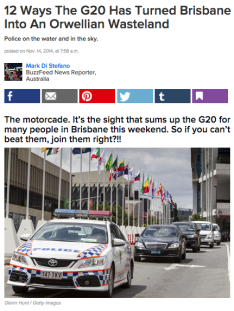 “Mark’s approach – because he was only one reporter – had to be like a beat reporter. When the G20 was on he was in Brisbane at the G20, when the AIDS conference was on he was on in Melbourne he was there, when ABC cuts happened, when there was the Sydney siege, he was there.”
“Mark’s approach – because he was only one reporter – had to be like a beat reporter. When the G20 was on he was in Brisbane at the G20, when the AIDS conference was on he was on in Melbourne he was there, when ABC cuts happened, when there was the Sydney siege, he was there.”
Buzzfeed’s critics argue the site is an aggregator and doesn’t generate much of its own original content, focusing more on social media reaction and online reaction to news.
However, Buzzfeed’s Australian boss hotly contests this view: “We’re not looking at how can we rewrite a story.
“As the news team we are doing the news but we are thinking about how can we tell the story to our audience?
“Now that might mean we might approach that in a different way – with the G20 it was explaining it in Beyonce GIFs – but I think our audience gets that.
“Frankly I think our audience understands it better probably than if we wrote 3,000 words on it.”
That’s not to say Buzzfeed Australia doesn’t do long form pieces. Di Stefano, recently promoted to Buzzfeed Australia’s first political editor at the age of just 25, recently did a 2,500 word profile of Australia’s youngest MP in Federal Parliament Wyatt Roy, focused on his decision to cross the floor on gay marriage.
Di Stefano notes that Buzzfeed’s somewhat unique approach to news is already playing off – and some making waves.
His emoji interview with foreign minister Julie Bishop, back in February, generated global headlines in everything from the MSNBC to the BBC to Russia Today.
“For me that was an interesting experiment: it was a ten minute text conversation with the foreign minister that just sparked all this coverage,” explains Di Stefano.
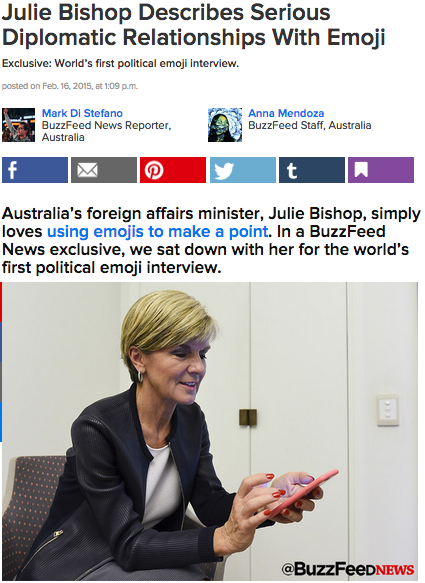 “There is no point to me sitting down with her and doing a Leigh Sales style interview – I’m not Leigh Sales.
“There is no point to me sitting down with her and doing a Leigh Sales style interview – I’m not Leigh Sales.
“What I can do is have a text message conversation that is revealing and says a lot about her as a person. I think that is valuable – doing something that is original and fun on the news of the day.
“We are trying to think about how young people consume news differently on mobiles etc. How can we get political news to them? How can we communicate Julie Bishop to those people?”
Is Buzzfeed Australia worried that this approach is dumbing down or over-simplifying the news?
“Today you are bombarded with so much noise,” says Crerar. “Journalism has always been about us as journalists taking very complicated things and explaining them in a way people can understand.
“If that includes lists, gifs, quizzes or videos, ok then, that doesn’t dumb us down.”
Changing perceptions
On the afternoon of the interview, the stories leading Buzzfeed’s news feed include: a splash on social media reaction to speaker Bronwyn Bishop’s resignation; “beloved echidna has been stolen by dickheads”; a story about an embarrassing tweet by Tony Abbott in 2013; and “the weather in Australia right now is batshit crazy”.
This is all interspersed around Buzz posts that included: “21 very real struggles for everyone who grew up with thick hair”; “25 cats that are 100% you”; “If these celebrities had Barbie proportions you would hate it” and a native sponsored post by Cornetto entitled “texts you should never send your crush.”
 Does that lighter context and approach limit Buzzfeed’s ability to be taken seriously as a serious news player?
Does that lighter context and approach limit Buzzfeed’s ability to be taken seriously as a serious news player?
“In Australia we have more people doing news than we have doing Buzz,” says Crerar, adding that those stories about hair, cats or Barbie celebs were created by overseas parts of the online behemoth which now employs 1,000 people globally.
“But obviously in the same way a piece of content about Khloe Kardashian does well for the Daily Mail or News.com.au then it has a similar impact for us.
“It has long been our position that we produce a lot of serious news content but we also do produce entertainment content as well, there is no shame in that.”
In Australia, Buzzfeed has fought to be recognised as a news site with digital industry body Interactive Advertising Bureau (IAB) and its audience measurement contractor Nielsen agreeing to move them from search engines and portals to a sub category of news last year but denying them the global news classification, a move that would see it compete with the top 10-15 news website based on audience.
Buzzfeed Australia is continuing to push for this to be revised – noting how it just got Canberra press gallery accreditation – and seeking the advertising premium that comes with a news classification.
- Related content: Nielsen to review Buzzfeed news classification as publisher lifts lid on local video strategy
Di Stefano believes the mission is to change perception: “Overseas – in the US and UK – this debate has been settled. They already see Buzzfeed as a pretty great news brand.
“It’s our job in Australia to now do the job that they have done.”
To this end Di Stefano – who Crikey dubbed “Mr Internet” – and the local reporting team, have already got some runs on the board.
Asked which Buzzfeed stories he is proudest of Di Stefano cites three: its recent scoop outing former Labor leader Mark Latham as being behind the online Twitter abuse of a number of high profile women – a story which eventually saw him quit the Australian Financial Review; its coverage of the Sydney Siege which gained local and international recognition thanks in part to its focus on social media; and the January controversy around Taylor Swift and the Triple J Hottest 100 which he describes as having “melted down” the Australian internet.
“The Mark Latham story was noteworthy because it led to a big scalp which was unexpected when we started reporting it,” he says of what was a true piece of social media investigative reporting.
Buzzfeed’s online push for pop star Taylor Swift to be included in Triple J’s hottest 100 – hashtag #tay4hottest100 – caused consternation among music aficionados and the ABC alike, with the singer eventually banned and ABC boss Mark Scott even being asked about it in Senate estimates.
On the Taylor Swift controversy Di Stefano proudly notes: “I’d argue that was a form of cultural criticism.”
More broadly, Crerar is using Buzzfeed’s social focus on identity to build out a reporting team built not around traditional reporting beats such as courts, health, education but rather on niche audiences.
He has hired a young reporting staff that includes Alex Lee as politics reporter, Lane Sainty covering LGBTI issues, Allan Clarke on indigenous affairs, along with Dean Nye as social media editor and Rob Stott as news editor.
“Alex is not a political reporter,” Crerar explains, noting that while Lee covers Canberra, “she covers both Canberra politics and identity politics as we see it.
 “Allan’s appointment came out of when (New York based editor-in-chief) Ben Smith was here and he and I talked a lot about what the opportunity is for us here in Australia and in particular what do young people here really care about?”
“Allan’s appointment came out of when (New York based editor-in-chief) Ben Smith was here and he and I talked a lot about what the opportunity is for us here in Australia and in particular what do young people here really care about?”
Crerar cites a post they did criticising Tony Abbott for claiming Australia was “unsettled” before white settlement: “We did the potted history of why Australia had been this rich society for 30,000-40,000 years and it got half a million views.
“That blew up and did the biggest numbers for any news story last year. It was a wake up call for us and realised it was something that young people really do care about.”
The choice to focus on issues such as gay rights and indigenous affairs might lead some to see Buzzfeed as sitting on the left of the political spectrum but Crerar rejects this.
“I think we are trying to appeal to all Australians whatever their political persuasion is and that means reporting stories objectively,” he says.
“I mean I certainly don’t wake up and think: where do we sit in the political spectrum?,” he adds almost as an afterthought.
“That said there are certain things we very much stand for: we believe people should be able to marry who they want, who they love, we believe there is no argument to be had on racism.”
Building a native business model
While some of the publisher’s individual posts might draw half a million views it’s worth noting there is no display advertising behind the business model.
Buzzfeed leads the publisher space in being a website that funds its operations through native advertising.
Asked about how the Australian operation is going commercially Crerar says it’s the one topic he isn’t allowed to comment on.
“What I can say is that from the beginning we have been working with brands to create great content,” he says, “with it being sold out of New York, creative done in Los Angeles.
“That has gone well enough and clients have been happy and excited about it, so that this year we have so far been able to put in four people and we have a couple more coming.”
“It will be great for brands because we will have people in Sydney and Melbourne who understand the subtleties of getting a brand message across in the Australian market.”
Native advertising – content paid for by advertisers which appears in the new stream – is a controversial topic, with comedian John Oliver taking aim at it last year due to the risk of advertising influencing editorial decisions, or the posts being mistaken for news.
It’s criticism Buzzfeed globally is particularly vulnerable to after it deleted and then reinstated stories critical of advertiser Dove in April.
Crerar, however, isn’t concerned about criticism that native has the potential to undermine a publisher’s credibility.
“Our entire business model is native content because we don’t believe in banner ads, we think banner ads are dead but native isn’t a new proposition,” he opines.
“Magazines have been doing it for decades. Likewise newspapers have had advertorial and I think it is very clear what is and isn’t a piece of branded content,” he says, adding: “I don’t think it hurts our reporting anymore than it hurts The Australian’s reputation to have an ad for Mercedes Benz on page four.
“That is what funds the journalism.”
Globally it’s also a model that appears to be sparking interest with NBC Universal investing US$200m into the company – a move which valued the so-called “cat video company” at a cool US$1.5bn.
Finding local voice
But the reality is Buzzfeed will always have its critics.
A few weeks ago, Aussie musician and The Great Gatsby actor Brendan Maclean, who has a strong social media presence on Twitter, took aim at the site, tweeting that its Australian operation sucked “giant sweaty boring clickbait balls.”
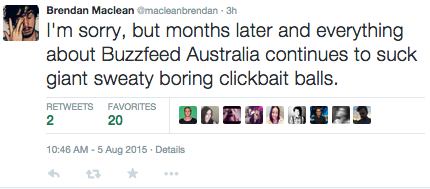 The comment was remarkable only because the response from Buzzfeed hinted at a thin skin. Its young reporting staff responded to the single tweet – indirectly – by quickly favouriting the tweet and then tweeting out some of the recent Buzzfeed Australia stories they were proudest of.
The comment was remarkable only because the response from Buzzfeed hinted at a thin skin. Its young reporting staff responded to the single tweet – indirectly – by quickly favouriting the tweet and then tweeting out some of the recent Buzzfeed Australia stories they were proudest of.
Had Maclean hit a nerve? Buzzfeed editors Crerar and Guillaume are reluctant to be drawn on the comment or their staff’s subsequent response.
“We have a no haters policy,” says Guillaume. “We are not haters and we don’t engage with haters,” she explains, with her and Crerar adding that they don’t consider Maclean a “hater”.
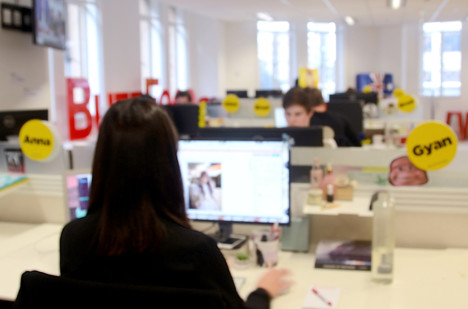 Crerar expands: “All of us here are very proud of what we are doing and we really love working for Buzzfeed.
Crerar expands: “All of us here are very proud of what we are doing and we really love working for Buzzfeed.
“We understand that some people might not get what we do, or like what we do, but our general approach is not to get involved in slanging matches.”
Finally, after 18 months does Crerar think they have found their Australian voice? “We are early on here in this market but one of our core goals is to establish our voice,” he says.
“I won’t say we have totally nailed it yet, we are still on that journey, but we are on the way to getting there.”
Crerar explains that while he wants his young online publication to reflect Australians, he also sees Buzzfeed as bringing an international conversation to young people in Australia.
“I know, I felt when I first got to Australia that the media was very parochial,” he says.
“Young people have really broad horizons – the internet allows them to do that – and now they can get on Buzzfeed find out things that are happening around the world, beyond Australia.
“That is a key thing we are trying to do editorially is to focus on Australia as a really diverse multicultural society and we feel there are huge untapped audiences there.
“There is an opportunity there.”
- Nic Christensen is deputy editor of Mumbrella.
Simon Crerar is speaking at next month’s Publish conference on the future of news – a look at how news will be produced in the social media world; how it will be consumed; and how to make money out of it. For more information click the below banner.

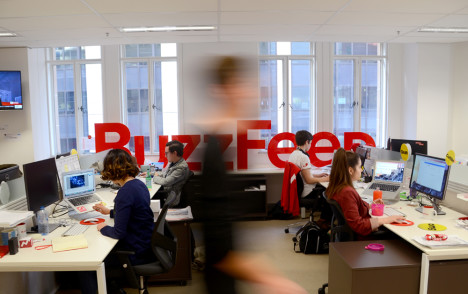

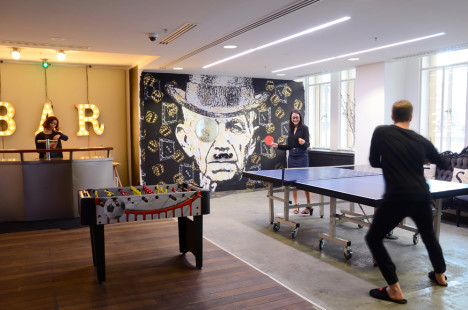

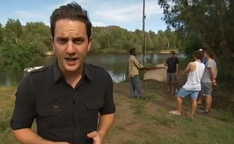


if this was in a list format i’d probably have read it.
Sorry but the only story they’ve broken (Latham) was broken in the Oz’s media diary months ago. I hate to praise Sharri but it’s a fact.
News, or investigations, this aint.
The question is, Can a company known for cat videos do news?
Yes it can.
And now, channel7, is doing cat videos as prime time programming. Funny ole world.
I don’t doubt Buzzfeed has some good content at times, but the click bait rubbish is (or at least was) so bad, that I will actively avoid visiting the site, to the extent of suggesting friends avoid it to.
Also this quote;
“Buzzfeed is a place where you can find what is going viral but also find original content that then goes viral.”
It makes me feel ill. All this focus on how to force your content to go ‘viral’ or that the public really care about ‘viral’ content.
What happened to good content with no gimmicks or tricks?
The more I learn about the Marketing and Advertising industries, the more I feel Bill Hicks was right.
“Now that might mean we might approach that in a different way – with the G20 it was explaining it in Beyonce GIFs”
Says it all really.
does Mumbrella have a stake in Buzzfeed? The incessant stories, and this fawning profile, seem to hint at such a relationship